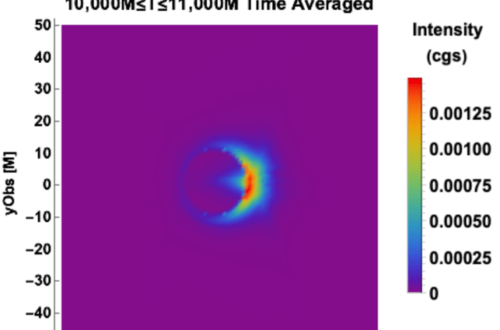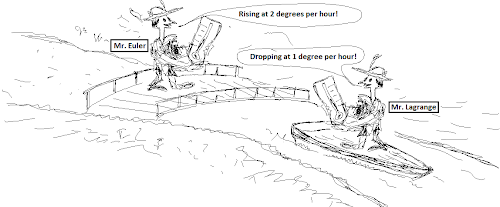With my post, I would like to summarize work that my colleagues and I published recently (Beuchert et al. 2019, A&A, 610, 32). Let me start with a general introduction to provide the necessary context needed to understand what “jets” are.
One of the major open questions in astrophysics deals with the most powerful objects in the Universe. We find them in the very centers of so-called Active Galaxies, where we expect at least one very heavy black hole (a Million to a Billion solar masses) to reside. In the consequence of its attractive force combined with friction occurring within the dense matter in orbit around it, matter will slowly spiral onto the black hole. In very simple terms, the matter drifting inwards, eventually loses its gravitational energy just like a ball dropped from a tower. Several processes turn this released energy into light, which shines all the way from the longest (X-ray and Gamma) to the shortest (radio) wavelengths and makes these objects about a Billion times brighter than our sun. On top of that, these “nuclei” of Active Galaxies expel parts of the in-falling matter far into the intergalactic space via confined matter streams. These so-called “jets” appear as intriguing, fragile pencils that drive matter along twisted magnetic fields at nearly the speed of light. The magnetic field is anchored in the close environment of the black hole – the details of which are still a subject to debate. It is key to understand the physics of jets, if we want to push forward a more profound understanding of Active Galaxies as the most efficient power plants in the Universe.
To do so, it is very important for us to see with our own eyes, how jets evolve. This harbors two problems. First, jets are rather faint in the visible light. Second, they are very far away. As matter gets accelerated within the magnetized jets, long-wavelength radio light is emitted that needs to be bright enough for us to detect it. At the same time, we are interested in a very small portion of the jet just after its launch and its internal structure. This is where information is stored on how they are going to evolve and impact the intergalactic space – a true challenge for modern telescopes. The not-too-distant galaxy 3C 111 and its extraordinary bright jet turn out as a perfect object for our study. How can we make the radio light visible? We use radio telescopes that are much bigger (>20m in diameter) and more advanced versions of a satellite dish on our roofs. With a single radio telescope we can just “listen” to the changing intensity of the radio light from deep space. Our goal, however, is to make images. To do so, we point a large network of radio telescopes to the jet we are interested in and use a technique called “interferometry”. It would take a second blog post to explain this concept properly, but let me try to summarize it in one sentence: Time delays between signals arriving at pairs of antennas also encode the actual extension of the source structure. The images we can reconstruct are pretty close to reality. The larger the network, the better is the resolution of our image. We use data by the MOJAVE program that monitors a large number of galaxies and their jets with the Very Long Baseline Array (VLBA). The VLBA spreads across Northern America with a maximum diameter of 8611km. With this network we can actually resolve the desired structures that are not larger than an astronaut as seen on the moon.

For 3C 111, this results in an image resolution of a few light years. Compared to the entire jet-length of hundreds of thousands of light years, this resolution is outstanding. By comparing tens of monthly spaced snapshots, we found what has already been known for other, comparable jets. The following figure shows all observations of the same jet at different times. The separation of the images is larger the more time lies between the observations.
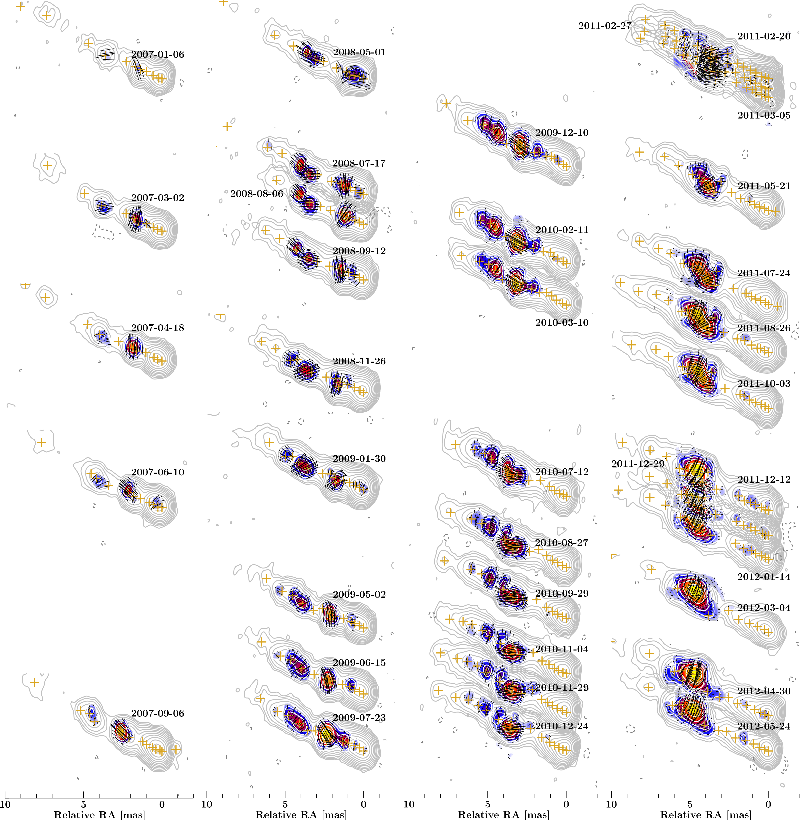
Chunks of matter that are expelled by the jet appear as distinct radio-bright patterns (constrained by gray contours) that are moving downstream. In our work, we focus on specific properties of that light, namely the regions emphasized in color. Radio waves are emitted by charges that are forced to spiral along the jet’s magnetic field. The produced radio waves therefore oscillate with a preferred angle on the sky, which we call “polarisation”. Matter that is accelerated by the jet continuously compresses the jet-magnetic field to the shape of a pancake while heading downstream. These “shocks” that move through the jet therefore also enhance the polarised light. The polarisation angle stays in clear relation to the plane of these shocks and is marked with black lines. What if we stacked all these individual images into one? The top figure below shows exactly that. The gray contours enclose the sum of the radio light emitted at any point of the jet over the four years of data. The color-coded area sums its polarised portion. 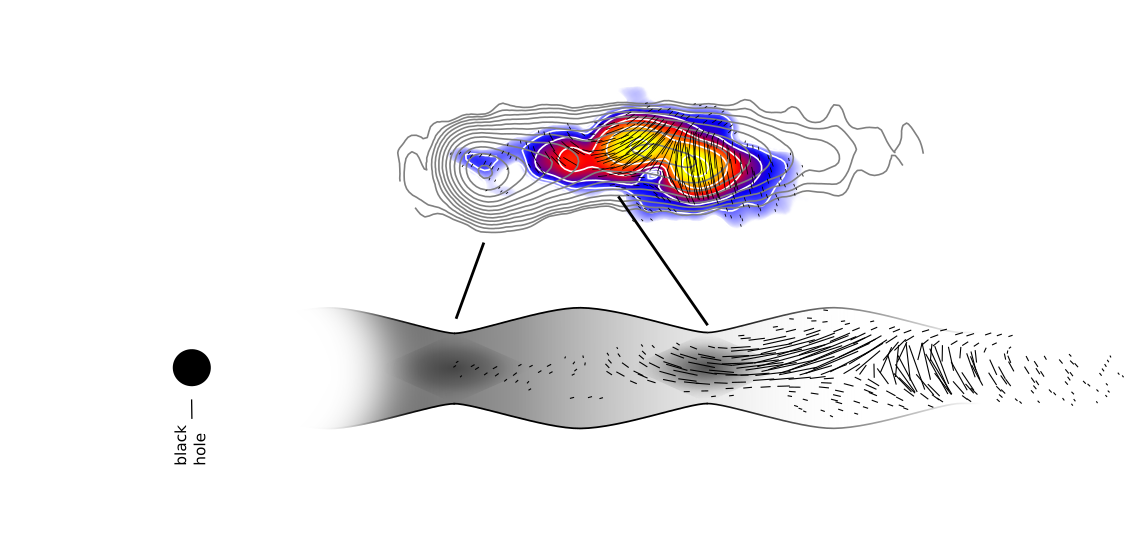
The colorized area traces the polarised emission emitted by all shocks that have passed the jet within these four years of data. The integration over all these shocks causes the polarised light to form the blurred and elongated distribution that is visible here. The polarization angles shown above the integrated polarised emission, are averaged polarization angles. If the angles of a single region would differ by 90 degrees between the stacked images, the average angle would have zero length and “cancel out”.
These polarisation average angles tell an intriguing story. These angles consistently draw a large swing of >= 180 degrees over the entire jet visible to us. This is a unique result that could only be seen in this jet. Remember that we show averaged angles, with perpendicular ones cancelling each other. The only way to draw this pattern of averaged polarisation angles along the jet is that all shocks that have been passing through the jet, must have moved and behaved very similarly. Finding an interpretation for this common behavior is challenging. We propose that a localized region in the jet remains compressed at all times, consistent with what is known from rocket exhausts and what is expected for any supersonic stream of matter: in these flows a series of “standing” shocks form that, as their name suggests, do not move as “normal” shocks. This is shown in the following image:
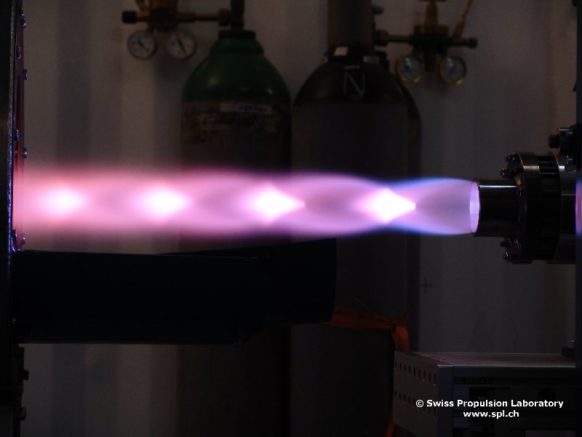
Theory predicts that the propagating shocks (those that give rise to the polarised light) may interact with such a “standing shock” and trigger complex dynamics that eventually lead to the observed large swing of the polarization angles. The reason for that has to be investigated with suitable simulations including all the necessary physics. Such simulations are on the way. Our results will provide a unique observational reference.

